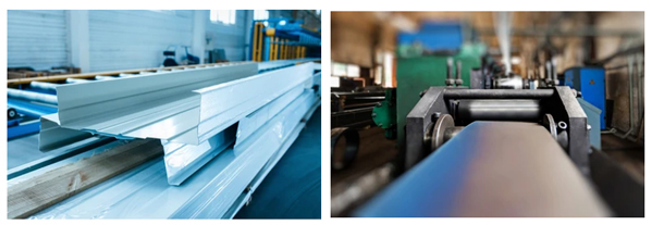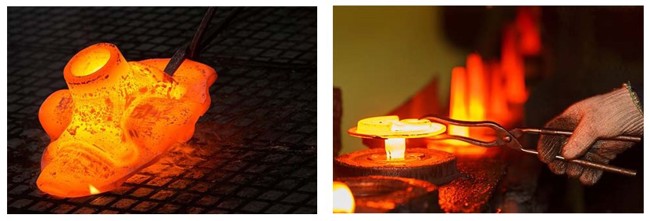Introduction - What is forming?
Forming sheet metal is one of the most critical processes in fabricating and manufacturing parts and components. In sheet metal forming, metals are reshaped in their solid state while they are still solid. The plasticity of certain metals allows them to be deformed into desired shapes without losing their structural integrity. Metal punching, extrusion, press braking, rolling, forging and laser cutting are some of the more common forming processes. Here are more details on each technique:
Common Types of Forming
The most common metal forming techniques are as follows:
1. Metal Punching
The metal punching process uses a punch press to punch, form, and cut metal as it passes through or underneath. By using a metal punching tool with a matching die set, you can create custom designs on metal work pieces. The punching process shears through metal to create a hole. Once the workpiece is clamped into a die set, male punches and female dies are inserted so that the sheet metal is cut into the desired shape. Though some punch presses still use manual operation, most modern punch presses use CNC (Computer Numerical Control) machines. Forming metals in high production volumes by punching is an efficient and cost-effective process.
Punching Video
2. Extrusion
Extrusion is the process of forming a metal by forcing it through a narrow opening which has a constant or varying cross-section to extend it and reduce its diameter. By pushing the metal work through the opening, the die is opened. Hot or cold extrusion processes can be used. A range of products is manufactured by extrusion, including tubes, cans, shafts, cups, and gears.
Extrusion can be classified as either forward or backward. In forwarding extrusion, the work piece and the punch move in the same direction, whereas in backward extrusion, the motion of the punch opposes the direction of movement of the work piece.
The most common extruded materials include polymer, concrete, metal, ceramic, food, and modelling clay. Following are a few types of extrusion processes:
- Direct
- Indirect
- Hydrostatic
- Tube
Extrusion Video
3. Press braking (Metal Bending)
Sheet metal bending is an extremely common process and is used not only to form shapes and add stiffness to components but also to form seams, corrugations and flanges.
Press braking is a forming process for sheet metal that involves the bending of the work piece. When applying bending stress, the sheet metal is bent until it deforms into the desired shape and cannot return to its original shape. This technique is used to create parts such as flanges and corrugations.
The most common form of bending is a V-bend. To make the sheet the required shape, we assemble a punch press and a V-shaped die. Edge bending is another option for creating flanges. A punch and wiped die are used to achieve this. Additional bending processes include:
- Channel Bending
- Offset Bending
- Edge Bending
- U-Bending
- V-Bending
Press Braking Video
4. Rolling
Roll forming involves bending sheet metal in a series of operations. Roll forming lines feed sheet metal through roll stations. The roller dies are located on both sides of the sheet at each station. The rollers can be positioned at different angles on the sheet. The work piece is bent and deformed by forcing the sheet through roller dies.
In addition to being classified according to the temperature of the work piece, rolling can also be classified into hot and cold rolling. A metal that is above its recrystallization temperature is said to be hot rolled, while one that is below it is said to be cold rolled.
The rolling process is used to manufacture semi-finished products, such as sheets, plates and bars, and finished products, such as channels, angles, and sections. Rolling processes include the following:
- Flat rolling
- Shape rolling
- Ring rolling
- Thread rolling
- Gear rolling

5. Forging
During forging, die and punch are tools used to shape the billet into the finished part by applying tensile and compressive forces. Bulk-formation processes can be performed in an open die or a closed die.
An open die forming process is often used to shape raw materials before they are machined or formed. For example, thinning or drawing out is done by open die forming, whereas closed die forming squeezes the raw material (billet) between shaped dies.
Pump parts, small gears, valve parts, spanners, connecting rods, etc., are commonly produced using closed die forming.
Temperature is the key factor in determining if a forging process is classified as cold, warm, or hot. The latter two are typically executed in a forge.
The coining process is also part of the bulk-forming process. Coining involves applying a compressive force to the raw material’s surface to impart special shapes onto it. Below you will find a list of the most common forging processes.
- Roll forging
- Cogging
- Open-die forging
- Swaging
- Press forging
- Impression-die forging
- Upsetting
- Automatic hot forging

6. Laser Cutting
Laser cutting is a fabrication technology that subtracts material from a work piece by means of a high-powered laser beam—is increasingly common. Laser cutting makes it possible to design and produce complex parts and components without having to design bespoke tools.
By using a high-powered laser, metal is burned faster, with greater precision, and delivers smooth edges. With CNC laser precision, parts are not contaminated by material or waste, nor are they damaged as much as with other conventional cutting methods.
This article provides some insight into the different types of sheet metal forming operations, and we hope it has assisted you in identifying and understanding these different types of sheet metal forming processes.
Press Braking Video
Looking For an Expert Sheet Metal Fabricator Near You?
In terms of metal forming, there are a variety of processes to choose from, each of which offers a different set of benefits and detriments, and each of which is suited to certain kinds of metals.
Omnidex Sheet Metal Forming Services
With numerous automated machining centres, stamping machines, cold heading machines, milling machines, grinding machines and EDMs in addition to our partners, OmnidexCN is able to support every component regardless of the development stage or mass production.
You can find out more about our high-quality punches and dies by contacting us.











Water Sector Talent Exodus Could Cripple The Sector
Well let´s do a little experiment. My last (10.4.25) half-yearly water/waste water bill from Severn Trent was £98.29. How much does not-for-profit Dŵr...